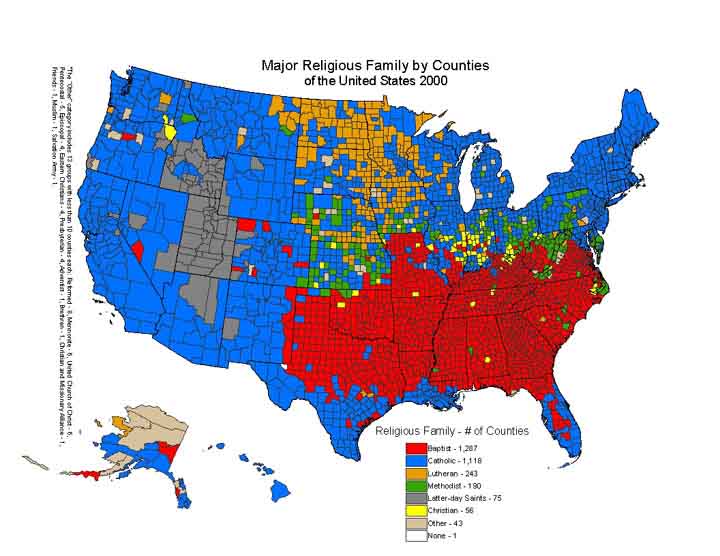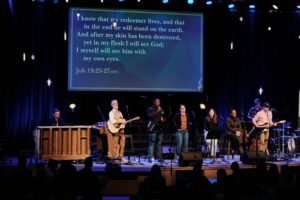
NASHVILLE, Tenn. (BP)–At first glance, the 20 million Southern Baptists tallied in a sweeping “Religious Congregations and Membership: 2000” study are 4 million more than the convention’s membership records indicate.
The catch is, the study of 149 U.S. denominations counts “adherents” as including youth age 14 and above, as a way of balancing totals both from churches that do not baptize infants as well as churches that do.
According to the data, Southern Baptists, up 5 percent during the 1990s, are among the denominations experiencing growth, whatever measure is used.
The once-a-decade study, begun 50 years ago, garnered media attention across the country — and atop the findings, as noted by The New York Times, is that, “Socially conservative churches that demand high commitment from their members grew faster than other religious denominations in the last decade…”
And denominations described in the media as “mainline Protestant” or “liberal” — such as the United Presbyterians, United Methodists and Episcopalians — were continuing their decades-long erosion in membership.
“I was astounded to see that by and large the growing churches are those that we ordinarily call conservative,” Ken Sanchagrin, a professor and chairman of the department of sociology at Baptist-affiliated Mars Hill (N.C.) College and director of the Catholic-affiliated Glenmary Research Center which published the study, told The Times.
“And when I looked at those that were declining,” Sanchagrin continued, “most were moderate or liberal churches. And the more liberal the denomination, by most people’s definition, the more they were losing.”
The study, while published by the Glenmary Research Center in Nashville, Tenn., was sponsored by the Association of Statisticians of American Religious Bodies, with the Lilly Endownment, Inc., as the primary source of funding.
(The study is separate from another Lilly-supported study also released in mid-September titled, “U.S. Congregational Life Survey,” which, concerning Southern Baptists, noted that compared with worshipers in other congregations nationwide, Southern Baptists generally are more involved in their congregations, spend more time in private devotional activities, are more likely to be tithers and much more likely to hold a strong view of biblical authority and interpretation. See Baptist Press from 9/23/02 at www.bpnews.net.)
Among the denominations showing significant growth in the Glenmary study, and outpacing the 5 percent growth recorded among a reported 41,514 SBC churches, were:
— Presbyterian Church in America, with 1,441 churches, up 42.4 percent.
— Christian and Missionary Alliance, with 1,878 churches, up 21.8 percent.
— Evangelical Free Church, with 1,365 churches, up 57.2 percent.
— Assemblies of God, a Pentecostal denomination with 11,880 churches, up 18.5 percent.
— Church of God, another Pentecostal denomination, based in Cleveland, Tenn., with 5,612 churches, up 40.2 percent.
— conservative Christian Churches and Churches of Christ, numbering 5,471 churches, up 18.6 percent.
An exception to the conservative trend was the Lutheran Church — Missouri Synod. Its membership fell 3.2 percent during the 1990s, to 2.5 million in 6,077 churches.
Among the denominations continuing in decline during the 1990s:
— Presbyterian Church (U.S.A.), with 11,106 churches, down 11.6 percent.
— United Methodist Church, with 35,721 churches, down 6.7 percent.
— Episcopal Church, with 7,314 churches, down 5.3 percent.
— United Churches of Christ, with 5,863 churches, down 14.8 percent.
American Baptist Churches USA, another prominent national body, also declined, by 5.7 percent.
The mainline/liberal findings drew comment in a news release issued by the Institute on Religion and Democracy, a Washington-based organization, which describes itself as seeking reform of mainline denominations “in accord with biblical and historic Christian teachings.”
There is “nothing astounding” about the losses in such denominations for nearly 40 years, said Mark Tooley, who directs the IRD’s United Methodist studies initiatives.
“Churches that are faithful to their historic teachings, that offer transcendent truth to their congregants, that demand something morally of their people, and that believe in the need for personal conversion have a strong incentive to grow,” Tooley said.
“Churches that allow themselves to be defined by the secular culture’s definition of ‘inclusivity’ and ‘tolerance’ really have little to offer that will change hearts or inspire great loyalty, much less create membership growth.”
Tooley said liberal theology “brings spiritual malaise and membership stagnation almost everywhere it is tried. Liberal theology, with its de-emphasis on traditional Christian belief in favor of social activism, is committing demographic suicide. The future of Christianity belongs to robust orthodoxy, Protestant, Catholic and Orthodox.”
David Roozen, director of the Hartford Institute for Religion Research, told the Washington Post, meanwhile, that denominations generally regarded by scholars as theologically liberal have difficulty fitting into the spectrum between evangelicals and New Agers.
“They are never going to out-conservative the conservatives,” Roozen told the Post. “But if they start emphasizing ‘religion is your own choice — feel it if you feel it,’ then people start asking why they need church at all.”
The survey data can be accessed at the www.thearda.com website of the Association of Statisticians of American Religious Bodies in the “Interactive Maps and Reports” section.
–30–













